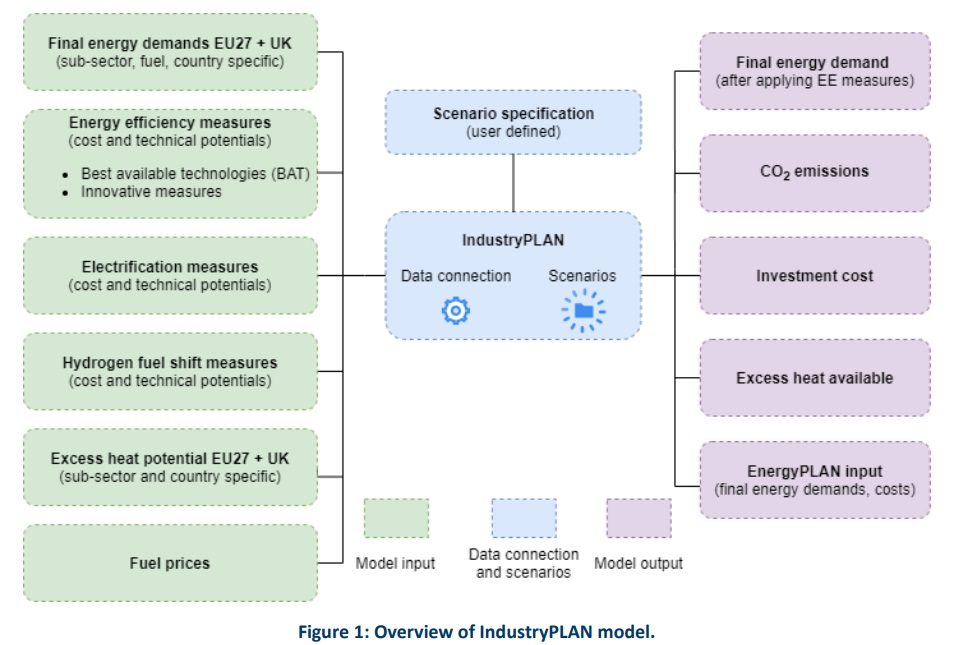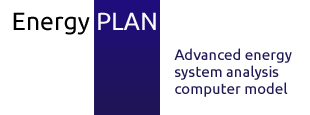The IndustryPLAN tool targets the lacking middle ground between highly site-specific analyses of individual production facilities and generalized nationally aggregated analyses. The purpose of the IndustryPLAN tool is to open the black box of industry and provide a framework for developing sub-sector specific analyses on both a country-specific and European level. This is done by establishing both disaggregated industry energy demands for all countries of the EU and an extensive catalogue of potential mitigation measures for the future. Applying the energy efficiency first principle, the IndustryPLAN tool provides a framework for investigating the industrial energy sector in the context of the renewable energy transition. The user is provided with a flexible platform for developing future industry energy scenarios based on a range of potential energy efficiency measure, electrification measures, and hydrogen fuel shift measure.

An important functionality of the IndustryPLAN tool is that the output can serve as an input for EnergyPLAN where further integrated energy system modelling can be conducted. This allows for analyses of how the industrial energy sector interacts with the surrounding energy system.
The IndustryPLAN tool was developed in the sEEnergies project completed in 2022. The tool can be downloaded here.
A detailed report describes the tool design and results, and its connection to EnergyPLAN. Download the report here.
IndustryPLAN scenario results from the sEEnergies project can be downloaded for each country here.
A basic description of the tool is presented below.
Scenario design
The process of designing a future scenario for the industry sector in IndustryPLAN is divided into two distinct processes; one for the implementation of mitigation measures, and one for excess heat utilization in district heating.
For the process of mitigation scenario design, there are numerous steps:
- The first step is selecting a recycling scenario which will then update the production volumes for all products accordingly.
- The user can then specify how much of the technical potential for BATs should be implemented, ranging from 0-100%. To do so, the user is assisted by cost curves for all the industry sub-sectors. The tool will automatically prioritize energy-saving measures based on their cost, with the lowest cost measures being prioritized first.
- Then, the user can initiate a VBA macro, making Excel repeat the process for all EU27+UK countries and export the results to a separate sheet where results for all countries are collected. The user will need to allow the user macros in the Excel file for this to work.
- The process for the excess heat scenario design is similar to the mitigation scenario design.
- Then the user needs to decide whether heat pumps should be implemented to boost the temperature of the excess heat from industry.
- The user then specifies general characteristics of the district heating system like forward and return temperatures, and finally technical parameters for the heat pumps.
- Lastly, the user can again initiate a VBA macro, which initiates a loop for all EU27+UK countries, and exports results to a separate sheet where results for all countries are collected.
Tool outputs
Final energy demands
Energy demands are available for all countries, sub-sectors, and fuel types. Energy demand in this context also includes electricity and hydrogen demand, and any potential increase in the demand that may have occurred as a result of increased electrification or shift to hydrogen-based processes.
CO2 emissions
Based on the energy demands per fuel type and the fuel emission factors, CO2 emissions are calculated for every fuel type and sub-sector.
Investment costs
Investment costs are calculated for the mitigation measures implemented and disaggregated per subsectors.
Fuel costs
Annual fuel costs are calculated for each scenario for three different price levels (low, medium, high) based on the fuel prices.
Excess heat
Results for excess heat production for district heating include the actual excess heat potential, the electricity demand for heat pumps if they are installed for boosting the temperature, and the investment costs for those heat pumps and the needed heat exchangers.



